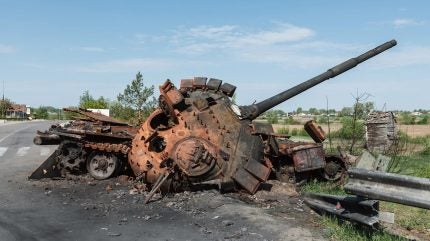
Ukraine has claimed its 10,000th Russian tank destroyed since February 2022, a landmark in the near three-year-old war that has likely seen more than one million combined military casualties.
The Ukraine-Russia war has been notable for the return of armoured warfare to Europe for the first time in generations, with the scale of equipment attrition, particularly for Russia, forcing the use of tanks held in reserve to be refurbished and pushed into the frontline.
To highlight the volume of equipment loss, in just the first ten months of the war, Russian forces were calculated to have lost more military platforms than seen during its two Chechen wars combined.
Since then, losses have continued to escalate, with Ukraine’s Ministry of Defence on 10 February 2025 also claiming over 20,000 Russian armoured vehicles knocked out or destroyed, in addition to the 10,000 tanks of various designs.
Other notable claims include nearly 23,000 Russian artillery platforms knocked out or destroyed, along with more than 1,200 multiple launch rocket systems.
Open-source intelligence gathering site Oryx states that Russia has had 3,740 tanks damaged, destroyed, abandoned, or captured. Of this, 2,672 are judged to have been destroyed.
However, Western officials broadly consider Ukraine’s claims to be reasonably accurate, with Kyiv’s reports of 850,000 Russian personnel killed or injured in the war close to the figures considered in the Western capitals. In January, the US Department of Defense said that Russia had suffered “more than 700,000 casualties”, a number that aligns relatively closely with Ukraine’s own claims.
According to GlobalData, Russia’s land inventory prior to its invasion of Ukraine indicated a potential fleet of 16,970 tanks, comprised of 550 1990s era T-90s, 3,450 T-80s and 8,950 T-72s from the 1970s, with a further 2,000 T-64s and 2,400 T-62s, originating from the 1960s. Of the new T-14 Armata MBTs, Russia was thought to hold around 20 in its order of battle.
By mid-November 2023, it was estimated that Russia’s invasion of Ukraine had cost Moscow more than 2,400 main battle tanks – equivalent to around 15% of its pre-war inventory – at the time.
It was reported in January 2024 that despite an increase in Russian MBT and other armoured vehicle losses in Ukraine, Moscow’s ramping up of its industrial capacity meant that it could replenish damaged or destroyed equipment. Russia is thought to be able to produce or repair at least 100 MBTs per month.
However, equipment losses have slowed since 2022, as the type of battles being fought in Ukraine shifted from combined arms operations to more basic infantry tactics, backed by immense use of artillery, glide bombs, and loitering munitions. Russia losses of combat vehicles in 2023 was around 40% fewer than in 2022, a trend that has continued as the focus shifts to infantry wave assaults.
Ukraine-Russia war: current operations
Amid ongoing rumours that US President Donald Trump is seeking ways to force an end to the Ukraine-Russia war, and as Washington’s own leadership of allied support of Kyiv comes under increasing scrutiny, combat operations continue along the front.
It is understood that North Korean forces have pulled back from the frontline having sustained up to 4,000 casualties in operations in Russia’s Kursk Oblast, with Ukrainian forces still holding onto some 320km2 of Russian territory.
In the east of Ukraine, Russian forces still maintain a bridgehead on the west side of the Oskil River near Kupiask. Near Pokrovsk, Russia is around 2km from its southern outskirts, with reports of heavy fighting at numerous locations along the frontline.
Russia is thought to have sustained some 50,000 military casualties since the start of the year, with daily claims by Ukraine of above 1,000 Russian personnel killed or wounded.
Despite this, it is considered unlikely that there will be any general mobilisation in Russia in 2025, should a ceasefire or peace deal be unable to be found, with existing financial incentives, heaving focussed on the rural areas and east of the country, replenishing human losses.
For Ukraine, it is thought that its most critical weakness is the diminishing pool of personnel, with recruitment drafts through conscription expected to reduce further from the current 25 years of age. Ukraine has sought to digitise much of its military recruitment in a bid to boost personnel numbers.



